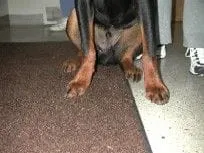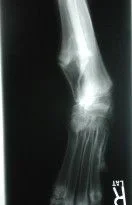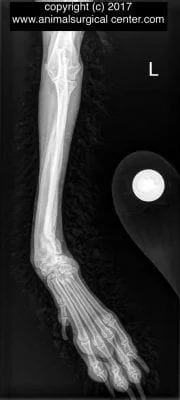Key Points
The growth plates are much softer than other regions of the bones, therefore are more prone to injury.
The wrist or carpus is prone to developing an injury of the growth plate of the ulna because it is “V” or cone-shaped.
If the dog is beyond the rapid growth phase then both radius and ulna bones must be cut to straighten the limb.
Anatomy
Growth plates, which are responsible for bone growth are located near the ends of the bones and are found in animals less one year of age. The majority of a dog’s growth occurs during four to eight months of age. When a pet matures at approximately one year of age the growth plates close and become invisible (or just a white scar line) on x-rays. Because growth plates are softer than other parts of the bone, they are susceptible to trauma and fracturing.

Because the majority of bone growth takes place by eight months of age, a growth plate trauma occuring beyond that age does not have as deliterious of an effect on the shape of the bone. Growth plates are the softest part of an immature bone, therefore are susceptible to trauma.
A Salter-Harris classification of growth plate fracture has been described in humans and may to relate to prognosis in dogs and cats. Type 5 injury to the growth plate is where the cells of the growth plate are crushed, but the actual growth plate is not displaced. The result is a scar at the level of the growth plate and no additional growth of the bone occurs. If the growth plate injury occurs in one of two paired bones (one bone grows and the other does not) the final outcome is usually devastating (see fig 1 of a Rottweiler with twisted right forelimb due to premature closure of the ulnar growth plate; x-ray of a limb with the twisted carpus due to the same is seen in fig 2).

Mechanism of limb twisting
Front limb
- The wrist or carpus is prone to developing an injury of the growth plate of the ulna because it is is V or cone-shaped (see illustration below). An impact such as taking a fall and landing on the front limb with full force can drive this cone-shaped growth plate together and result in severe damage to the cells. This type of injury is common in short-legged dogs. Another injury can be due to damage to the blood supply to a section of the growth plate and a cartilaginous core will develop and the bone growth slows down or stops. Cartilaginous core formation is more common in giant breed dogs.
- The growth plate at the lower part of the ulna bone (red line in illustration) is responsible for 90% of the growth of the entire bone. Therefore, the ulna essentially stops growing. The radius bone, which is the parallel bone to the ulna, continues to grow. This causes a bowstring effect, with the radius being bent like a bow due to its continued growth and the ulna staying the same length like the string of the bow.
- The wrist therefore twists and the elbow joint also gets pulled out of alignment (see illustration). The lameness in such a case comes primarily from the elbow incongruency (dashed circle in illustration), but also may be due to stress put on the collateral ligaments of the carpus.
- Another type of injury is closure of one side of the growth plate of the lower radius bone. In this situation the bone could twist toward or away from the midline of the pet (depending on which side of the growth plate is affected). This injury occurs when the limb is struck on one side of the foot.

Hind limb
- The hock or ankle sometimes develops a twisting toward the midline if the growth plate has been injured on the inner side. This problem is most commonly seen in Dachshunds.
- The knee or stifle may develop a twisting away from the midline (genu valgum) if there is asynchronous growth of the bone at the lower growth plate of the femur. This problem is very uncommon, but sometimes is seen in giant breeds such as Great Danes.
Surgery
Front limb
- If the dog is still growing (i.e. about 4 to 5 months of age) and the carpus is not twisted more than 20 degrees then removing a small section of the ulna bone and its associated covering (periosteum) will usually allow the limb to become straight again as the dog grows. Even (see fig 3).
Fig 3 
- If the dog is beyond the rapid growth phase then both radius and ulna bones must be cut to straighten the limb (see fig 4 before and fig 5 after surgery; a metal plate and screws was placed to keep the bones aligned). Sometimes the elbow congruency needs to be improved by cutting the ulna bone just below the elbow joint.

Fig 4. Before surgery

Fig 5. After surgery
Hind limb
- Angular limb deformity of the hock is treated by cutting the lower part of the tibia and using a plate or an external skeletal fixator to fix the bone in straight alignment.
- If the knee is affected the periosteum is stripped on the side that is not growing as well. This can stimulate that side of the bone to grow faster and therefore the limb will straighten. This is only useful if the animal is still growing (about 4 to 5 months of age).
Potential complications
- Anesthetic death
- Limb continues to twist
- Arthritis
- Infection
- Poor bone healing or nonhealing of the bone
- Breakage of the surgical implants (screws, pins, plates)
- Limb is shorter than the normal thus resulting in a gait abnormality


